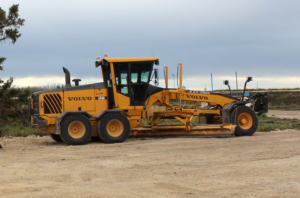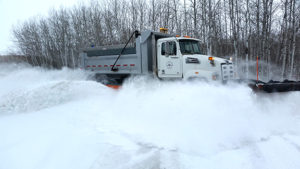
The RM of St. Clements has over 900 km of roads. Taking care of these roads is one the RM’s biggest responsibilities. We aim to keep roads safe and residents mobile.
Most of the roads are gravel. Gravel roads require constant maintenance and are unfavourably affected by wet weather conditions. Gravel, grading and dust control make up a large part of our budget. Significant resources are dedicated to maintaining, repairing and upgrading the road system.
Hard surface roads require less maintenance but are very costly to construct. This is the reason that these projects are usually done over a two year period. Engineering and base preparation is done in the first year and the actual hard surface is applied in the second year.
What is grading?
Road grading is the process of restoring the driving surface of a gravel road to a desired smoothness and shape by removing irregularities such as corrugations and pot holes and redistributing gravel. The grader operator will typically remove these irregularities by cutting the surface of the road or filling them with material moved back and forth across the road with the grader.
Click here to view the 2024 Hard Surface Capital Road Plan
Winter
We always monitor the roads to ensure they are functioning and safe.
Snow clearing
The RM tracks snowfall. When snow accumulation gets to about 5 cm (2 inches), we start plowing, even if the snow is still falling, otherwise we will begin once the snow is finished. Our goal is to have all roads cleared within three days of a snowfall. This is dependent on current weather conditions and the severity of the storm.
* Note: The province is responsible for clearing: Provincial Roads (PR’s), Provincial Trunk Highways (PTH’s) and Highways (HWY’s). If you need to contact them, you can reach them at 204-346-6266.
Snow clearing equipment
The municipality has six main pieces of equipment it sends out to six zones. Again, typically it takes two to three days to complete the whole municipality. Provincial roads are cleared by the province. Please call 204-346-6266 if you need to reach them.
If you require assistance, please contact 204-482-3300. Our office hours are Monday-Friday, 8:30am-4:30pm. We also have an after-hours service that will take your information and forward to the appropriate staff person.
To check on current road conditions if you are travelling, please visit https://www.manitoba511.ca/en/.
Sanding
- We sand icy intersections
- We sand gravel roads if they are icy
- We use a mix of sand with 5-15% salt
- When it is snowing, we sand after we plow to ensure the sand doesn’t get plowed off into the ditch
Help our Snow Clearers

- When plows are out, don’t park your vehicle on the road or at the end of your driveway in the path of the plow
- Please don’t push snow onto the road because if this snow gets hard and icy it can be jarring for the plow, which is travelling at a brisk speed, and can damage it
- This also can leave ridges on the road which make it bumpy for vehicles who drive over them
- If you push snow into the ditch, please push it past the range of the plow blade – by spring the snow can get very hard and compacted and again it can jar and damage the plows
- Do not install signs, markers, fencing, decorations or mailboxes too close to the roadways, as snow plows could damage them
- If you have private garbage pick up and it is snowing, please put the cans on your driveway at least 10 feet from the road, so they don’t slow down the plows and don’t get knocked over. If you put the cans on the road this causes problems for our snow clearers:
- They have to slow down and go around the cans
- The force of the cleared snow might knock cans over
- The plows will have to return the next day to replow those areas
* The RM is not responsible for damage to items that are too close to the road
Snow Plow Safety
- Maintain a distance of at least 50 feet from the rear of a snow plow so the driver can see you
- Avoid passing or driving beside plows as this can create whiteout conditions
- When a snow plow is approaching, teach children to stay off the road and snowbanks beside the road
Spring
Our road maintenance procedure is the same every spring, in the order below. All RMs maintaining gravel roads must follow this same routine.
- Roads are given a quick grading while the frost is coming out of the ground to get them temporarily into shape and ensure they are safe.
- Roads must be damp or dry to be graded. They can’t be graded when wet as that will makes the roads more muddy.
- Roads are then graded again to shape, crown and clean up the edges to ensure the road sheds water properly.
- New gravel is then added. We try to get this done as quickly as we can, most years gravelling is going on all of June but it can often continue into July.
- The timing of when gravel is applied depends on when road spring restrictions are lifted (usually in late May), the weather and the availability of the gravel contractor.
- Intense rain also affects fresh laid gravel when it has not had the chance to be rolled or packed by traffic. The gravel that we use meets specs and is tested regularly, although after a rain the fresh gravel may turn into a slippery consistency. Therefore we have to wait until it dries up some in order to get out with the graders to fix the road, as going out when too wet will further damage the road.
- Dust control product is then applied. Timing of this is also dependent on the availability of the dust control contractor.
About Spring Road Restrictions
What are spring road restrictions? Spring Road Restrictions protect roads from damage during spring thaw conditions by reducing allowable weights.
The RM has restrictions for municipal roads and the province has restrictions for provincial roads. Learn more on spring road restrictions here.
Dust Control
Gravel roads are dusty. This is part of the reality of living on a gravel road. When gravel roads dry out they can create dust in the air that settles in adjacent areas. The RM applies a coat of dust control (a liquid form of magnesium chloride) on the road in front of all homes to suppress the airborne dust. The timing of when we apply dust control depends on when spring road restrictions are removed, the weather, the availability of gravel supply contractors, and the availability of dust control contractors. Once ready, we try to apply dust control roughly a week after the road has been gravelled/graded, depending on weather and route may be sooner or later thus the reason why some roads are done before others.
The main reason we apply dust control is to reduce dust in front of homes. We do not apply dust control if there is no home, so there may be long, dusty stretches if there are no homes. If a road has particularly high traffic or heavy truck traffic, we might apply dust control even if there are no homes to ensure safer visibility.
We only apply dust control product once per year.
Am I able to purchase additional dust control?
Yes. Policy 350 was created to establish conditions and standards for additional dust control application to benefit private residences, at the residents cost. For more information and to learn how you can go about purchasing, click here.
When do you start dust control?
Dust control can begin when spring road restrictions are lifted and roads have been shaped and graveled, usually by late June. It can take three weeks to apply dust control to all the roads in the RM of St. Clements. The roads are graded before applying dust control to ensure good application and to help it last longer. We try not to grade the roads after dust control is applied as it ruins the dust control.
What do you use to control the dust?
We use a liquid form of magnesium chloride, a type of salt often extracted from sea water. Magnesium chloride continuously absorbs moisture from the air and literally traps water and locks it in. Magnesium bonds with fine dust particles in the roadbed to stabilize the soil which reduces dust, slows the loss of gravel on road beds and shoulders, and reduces the need for road grading. It reduces erosion and makes gravel surfaces harder and more compact. In addition, an ion exchange happens between the positive and negative charges further binding the road together.
Magnesium chloride applications can also reduce road maintenance costs:
- Can be used on many soil types
- Reduces potholes
- Help reduce washboards on roadways
- Stabilizes the soil resulting in less loss of road base
- Reduces the amount of overall road maintenance required and material to rebuild
Is dust control harmful?
Magnesium chloride, a naturally occurring mineral, is a type of salt extracted from sea water. This environmentally preferred compound can be used in sensitive watershed wetland areas and is recognized in Canada as a safe alternative to other dust reduction systems. It is approved by the U.S. Environmental Protection. In large concentrations, it can be corrosive and can damage plants.
Do I need to keep kids and pets indoors for a period of time after you spray?
No. Magnesium chloride is a non-toxic and environmentally friendly product, and there’s no odor during or after spraying. Not only is magnesium chloride non-toxic, but it actually helps prevent airborne disease.
Summer
Roads are maintained throughout the summer with regular grading, dust control application and application of gravel. Roads must be damp or dry to be graded. They can’t be graded when wet as that will makes the roads more muddy.
Fall
In the fall, we can get many requests to grade roads. Our general policy is that after freeze up, we don’t grade roads.
Why?
- When a road is graded, it creates a surface layer of loose gravel that is meant to be packed down by vehicles.
- After the road is frozen, the gravel won’t get packed into the road and will end up getting plowed into the ditch when the snow falls.
- Or else it will pack with the snow and be a hard surface for the winter, but come spring when it melts it will become a muddy mess.
